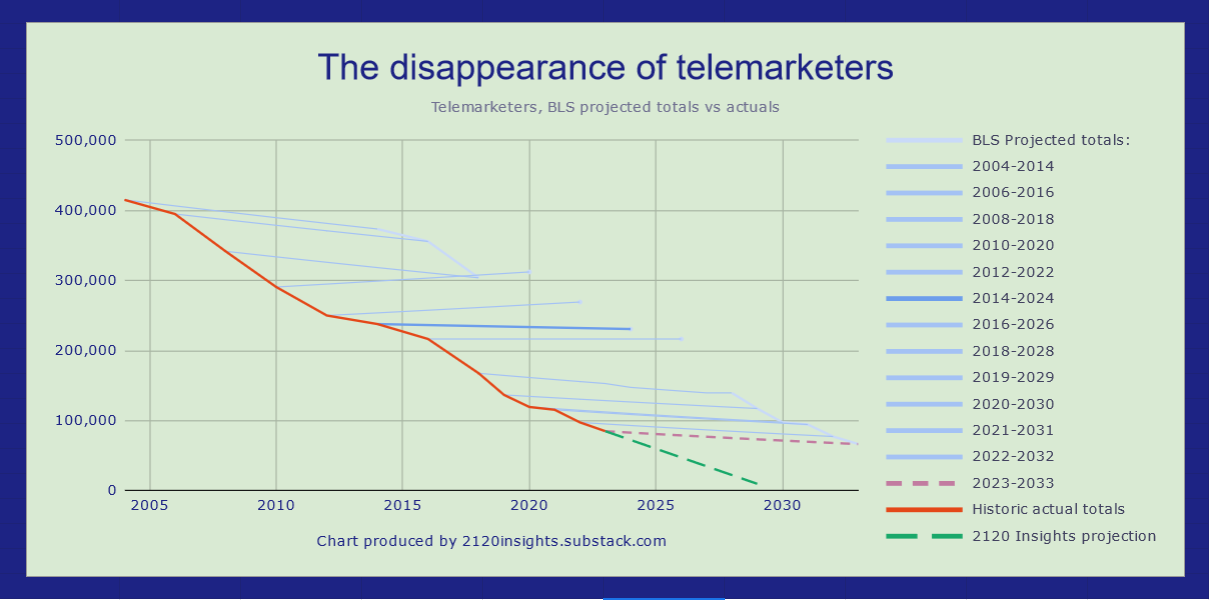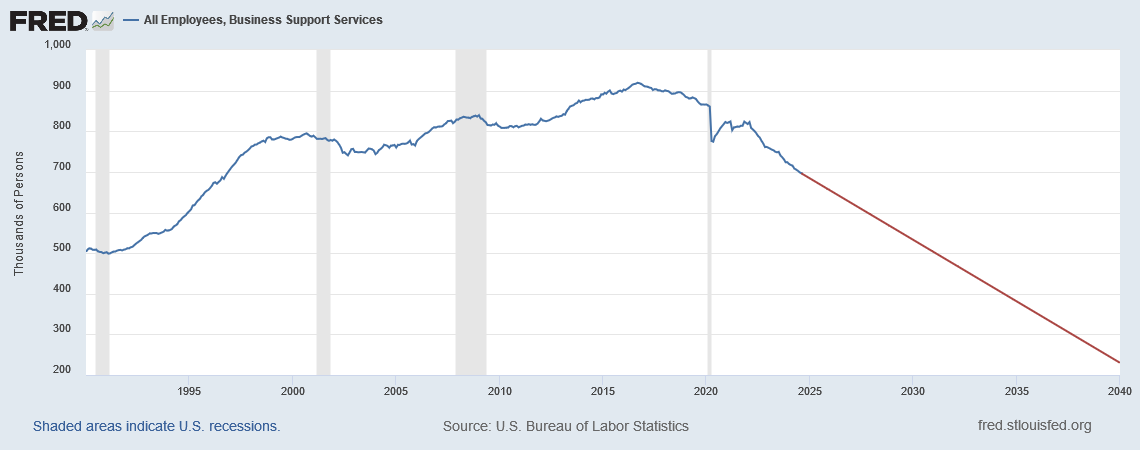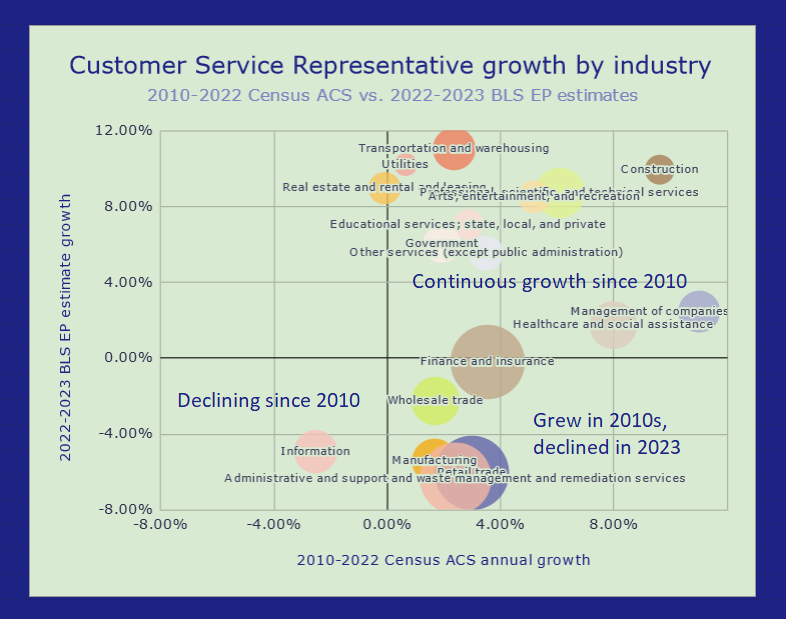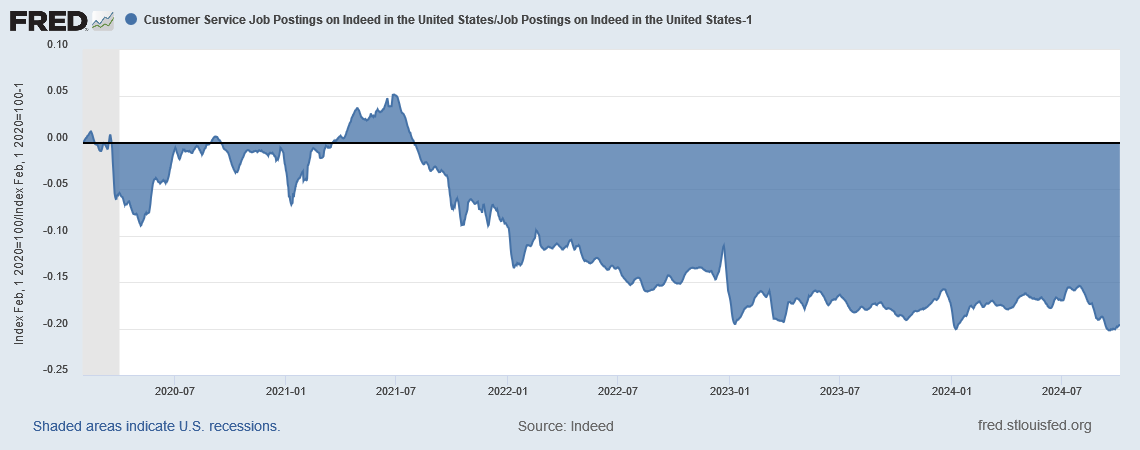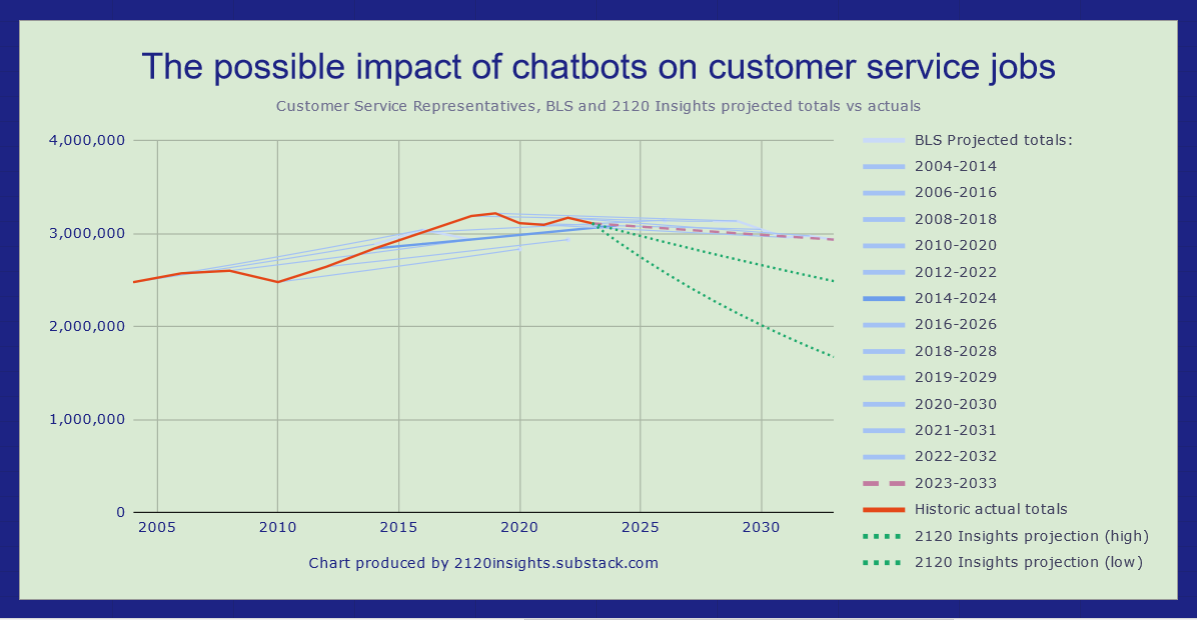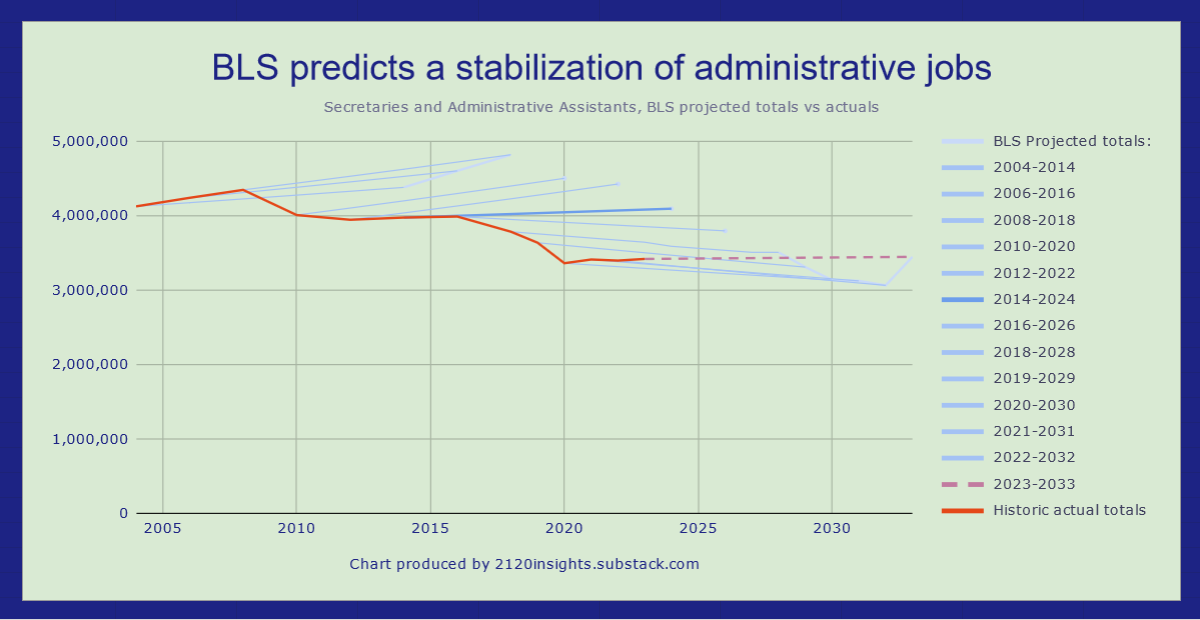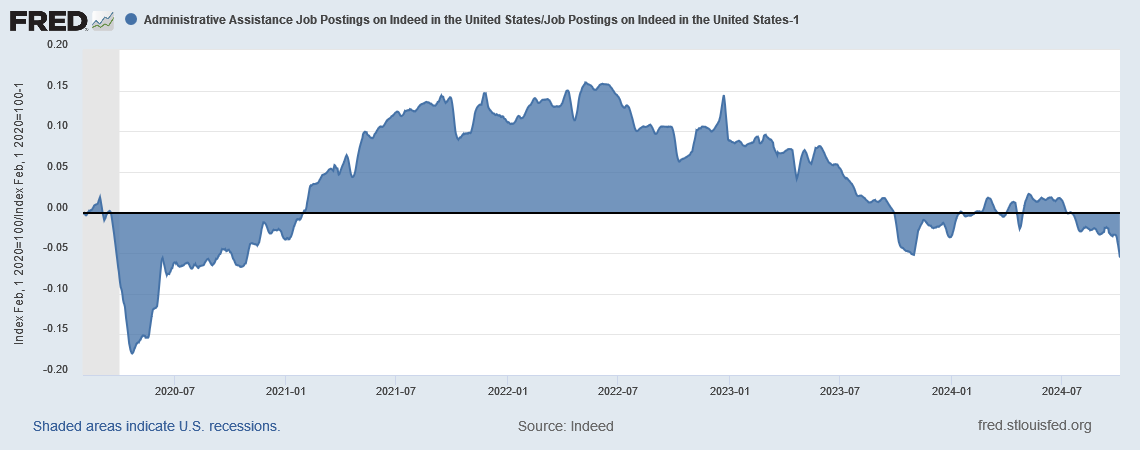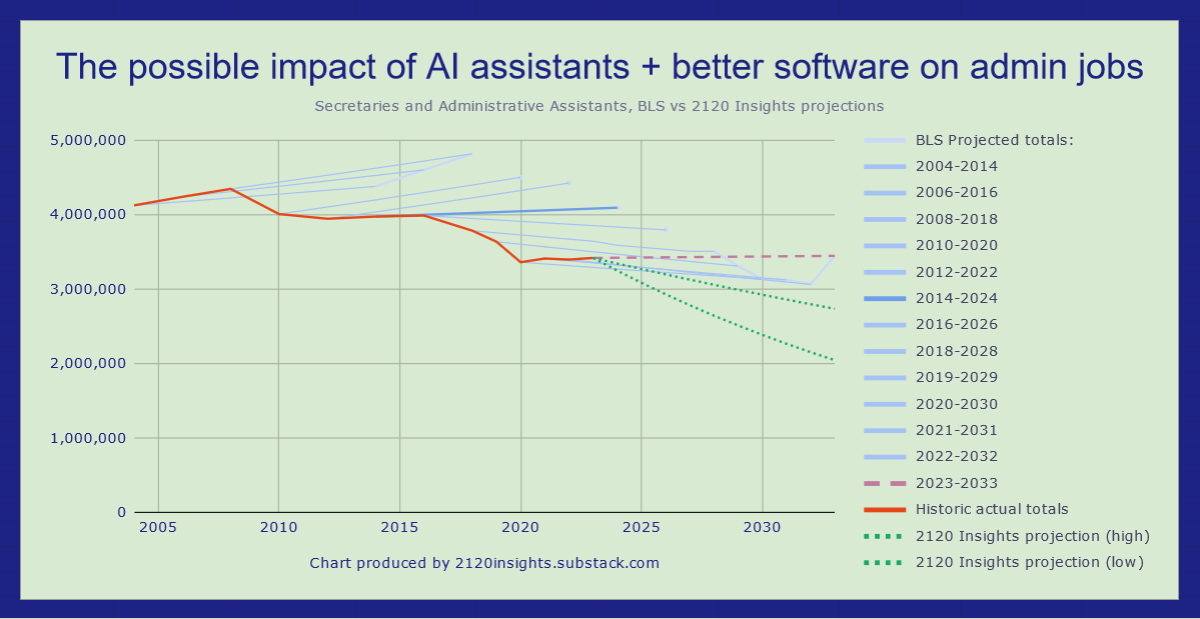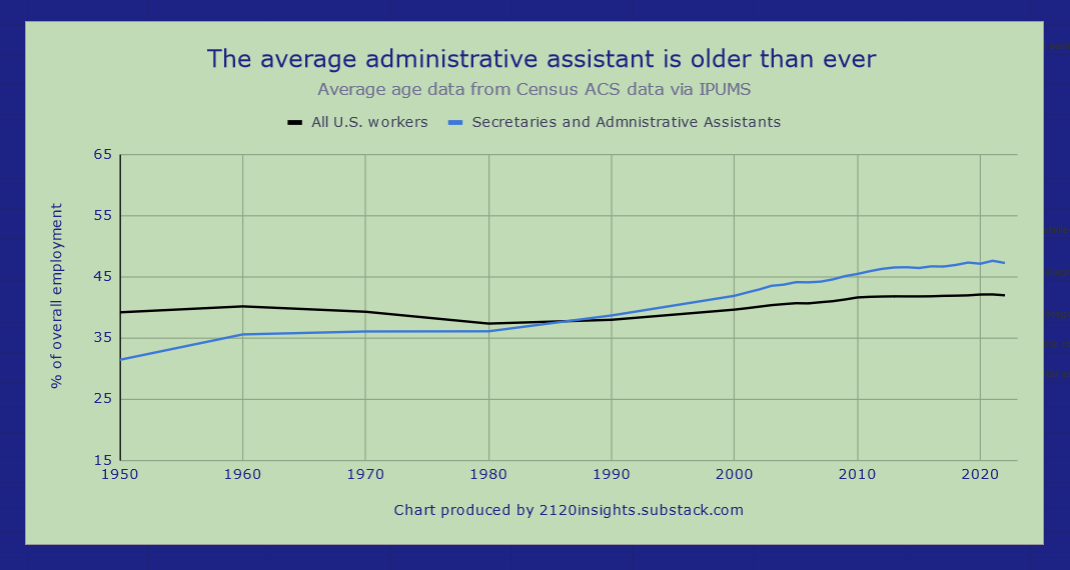Three jobs to worry about in the age of AI
Official forecasts understate how serious the decline is going to be
Reading through different forecasts about the future of work, I’m amazed by how much disagreement there is. On one hand, there are those close to the AI industry who hypothesize that Artificial General Intelligence is just a few years away and anyone whose job is primarily in front of a computer might get replaced by a drop-in remote worker. On the other hand, official forecasts like the latest one from the U.S. Bureau of Labor Statistics (BLS), are effectively predicting even less job change than usual.
It’s easy to dismiss the aggressive forecasts of pernennial techno-optimists (and doomers) as more of the same hype that has failed to materialize. Even their more in-depth explorations of this question often evade what specific numbers for particular occupations might look like over time. Meanwhile, official government forecasts like those from the BLS, as detailed as they are, can be unrealistically conservative, underweighting both historical trends in some cases as well as the potential impact of new technology.
Taking into account some lessons from predictions that were made almost 10 years ago, I’ve tried to bridge the gap between the hype and the realities of how complex the world truly is. If you or someone you know is considering future career paths, here are three jobs to avoid:
Telemarketers
Robocalls may finally be on their way down, but the number of telemarketers has been declining since at least 2004, down to just 1 in 2,000 workers in 2023. Based on current trends, this occupation looks set to join “elevator operator” and “motion picture projectionist” as a relic of the past by the end of the decade.
Of course, I doubt there are many people out there who consider telemarketing to be their calling. It is one of the least satisfying jobs out there. I’d be shocked if 66,800 Americans were still working in this field in 2033 as the BLS projects, given the historic trajectory. Even in 2020, only 19% of Americans answered unknown callers, a number that has surely dropped since then.
Customer Service Representatives
In May 2024, the Swedish financial technology company Klarna made waves by reporting that its AI assistant was able to handle two thirds of its customer service chats1. This is obviously a lot quicker than the 5% decline in customer service jobs predicted by the BLS.
Losing this many customer service jobs across the entire economy within the next year or two would be a nightmare scenario affecting two million Americans and would bring up unemployment by a whole percentage point on its own. Fortunately, change this fast across an entire occupation would be entirely without precedent and is extremely unlikely to occur so quickly. But the recent 5-6% annual losses in the business support services industry2 suggest it’s possible that we could get there sometime in the 2030s.
However, this is a worst-case scenario. Other industries have had better prospects, at least up to 2023:
Whether this same demand for US-based, human customer service workers will still be there in the 2030s is the key question. On one hand, 2023 BLS projections note that growth in healthcare is likely to continue due to “federal payment models emphasizing patient satisfaction”. But better software (which AI is likely to make cheaper) could also reduce the need for customer assistance, even in highly regulated industries and government where the adoption of labor-replacing chatbots and other AI-powered technologies might be slower.
This dramatic downturn in customer service representatives is already visible in Indeed.com job openings data, which has proven itself to be a moderately reliable forecaster of employment in this sector. Openings are down over 20% relative to the job market as a whole since early 2022 and continue to drop.
Unless we see a reversal in this trend, it’s reasonable to expect a 20% drop in customer service jobs over the coming decade at minimum. But at least 30% or more seems likely if we see technology further progress. If that comes to pass, it would mean roughly a million American workers, or 100,000 per year (6x more than the BLS expects) who if not near retirement could be looking for a new line of work.
Secretaries and administrative assistants
The number of secretaries and administrative assistants has been in decline since 1980. But the BLS’ projection for 2033 is quite remarkable: they projected a slight increase! This was one of their biggest revisions from the year before.
I think this is wrong. But I can understand why they were optimistic. From 2020 to 2023, the number of secretaries actually held steady, breaking the ominous trend that was apparent in this job in the late 2010s.
This might have been in part because job losses here were so steep in 2020 that layoffs were effectively “pushed forward” a few years. Indeed, we even see job openings in administrative assistance rise above the overall market in 2021 all the way through 2023!
That trend appears to be over though. October 2024 has started with another ominous drop in job openings in this field, and I suspect as a base case that we will return to the familiar decline in administrative work we’ve seen since the 1980s—at least another 20% drop, but possibly as high as 40% by 2033.
This would impact roughly a million workers, or even more if we include similar underestimates of the potential for further automation in other clerical occupations like billing, bookkeeping, accounting, and auditing clerks, as well as other smaller administrative occupations. There are even some second-order effects in other areas to consider, such as if fewer HR personnel or managers are needed.
The only bright side is that we’re unlikely to see a big wave of tech-induced layoffs in this field. The expertise that experienced administrative assistants accumulate about their organization over the years might make them safer from layoffs than other types of workers. The decline might be driven by retiring workers simply not getting replaced, or their duties instead getting distributed to other types of workers like “analysts”. The clearest evidence we have for this is that the average secretary or administrative assistant is now much older3 than the average worker.
I think this is an important trend to consider in an era of dramatic predictions about AI. The reliability of an experienced administrative assistant (and one who might make use of AI tools when appropriate) might win out against an untested AI “virtual assistant” for some time to come. But the calculus will surely be different when it comes to making a new hire.
The bottom line
Our fear of dramatic shifts in employment might be too informed by the manufacturing sector in the 1980s and 2000s, where plant closures eliminated large number of jobs all at once4. The customer service and administrative jobs most threatened by AI are in a much broader array of industries, each with their own unique considerations which reduce the odds that any single development will cause a lot of technological unemployment. In the absence of complete closures, the impact of layoffs on morale might temper job cuts compared to earlier dramatic declines in manufacturing. This might bring about a slightly softening labor market, with hiring at recession-era levels but layoffs still low, similar to what we are seeing today. Might we see a deepening of “The Great Stay”?
If so, then the most apparent threat is to younger people. Sales, customer service, and administrative assistance have historically been common entry-level jobs. As these opportunities evaporate, the uptick in youth unemployment has been notable and something to keep a close eye on. Combined with disruptions to education from pandemic-era school closures to curricula unprepared for generative AI, the next generation of job-seekers might be further disadvantaged even if more experienced workers manage to avoid tech-induced layoffs.
But just as technology destroys some opportunities, it creates new ones. Next week, we’ll take a closer look at a few jobs that are set to grow even more than the BLS is predicting. Can these make up for the nearly 3 million jobs we might lose by 2033?
Already reducing its headcount from 5,000 in 2023 down to 3,800 in 2024, it plans to cut down to 2,000 by the end of 2025
Many companies, including Klarna, contract out their customer service operations. For example, Klarna’s adoption of a chatbot agent reduced their number of contracted agents by nearly one third.
While the Business Support Service includes many different occupations, Customer Service Representatives have comprised at least 23% of the employees in this industry since 2014. No other industry has anywhere close to that high of a proportion.
Secretaries and Administrative Assistants are now among the top 20 “oldest” occupations.
It really is astounding how much manufacturing collapsed between 2001 and mid-2003— 2.7 million jobs eliminated in just 2.5 years. Even though there was an economic recovery in the mid-2000s, unemployment was still quite elevated compared to most years post-2017. Significant losses were seen in all areas of manufacturing (both durable and non-durable), beginning with textiles and apparel but also especially steep in computer and electronic product manufacturing.


